Australian Beef Industry Analysis
VerifiedAdded on 2020/04/07
|12
|1874
|322
AI Summary
This assignment examines the Australian beef industry through a SWOT analysis. It explores the industry's strengths, including high-quality production and technological advancements, as well as its weaknesses, such as low education levels among operational teams and inadequate training. The analysis also identifies opportunities for growth, such as distinct marketing of British-fed beef and expansion into new markets. Finally, it outlines threats to the industry, including financial instability in regional packing companies and competition from other beef producers.
Contribute Materials
Your contribution can guide someone’s learning journey. Share your
documents today.
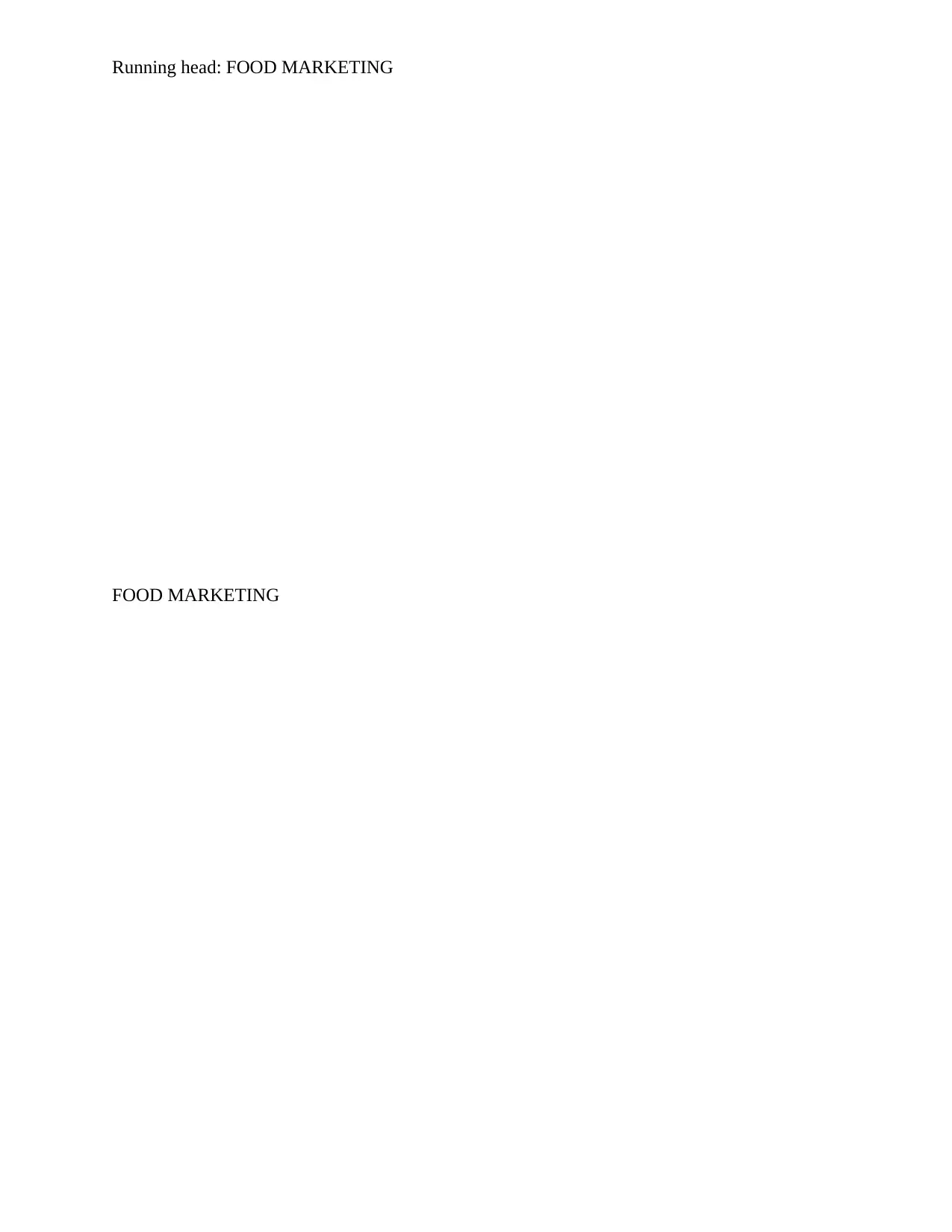
Running head: FOOD MARKETING
FOOD MARKETING
FOOD MARKETING
Secure Best Marks with AI Grader
Need help grading? Try our AI Grader for instant feedback on your assignments.
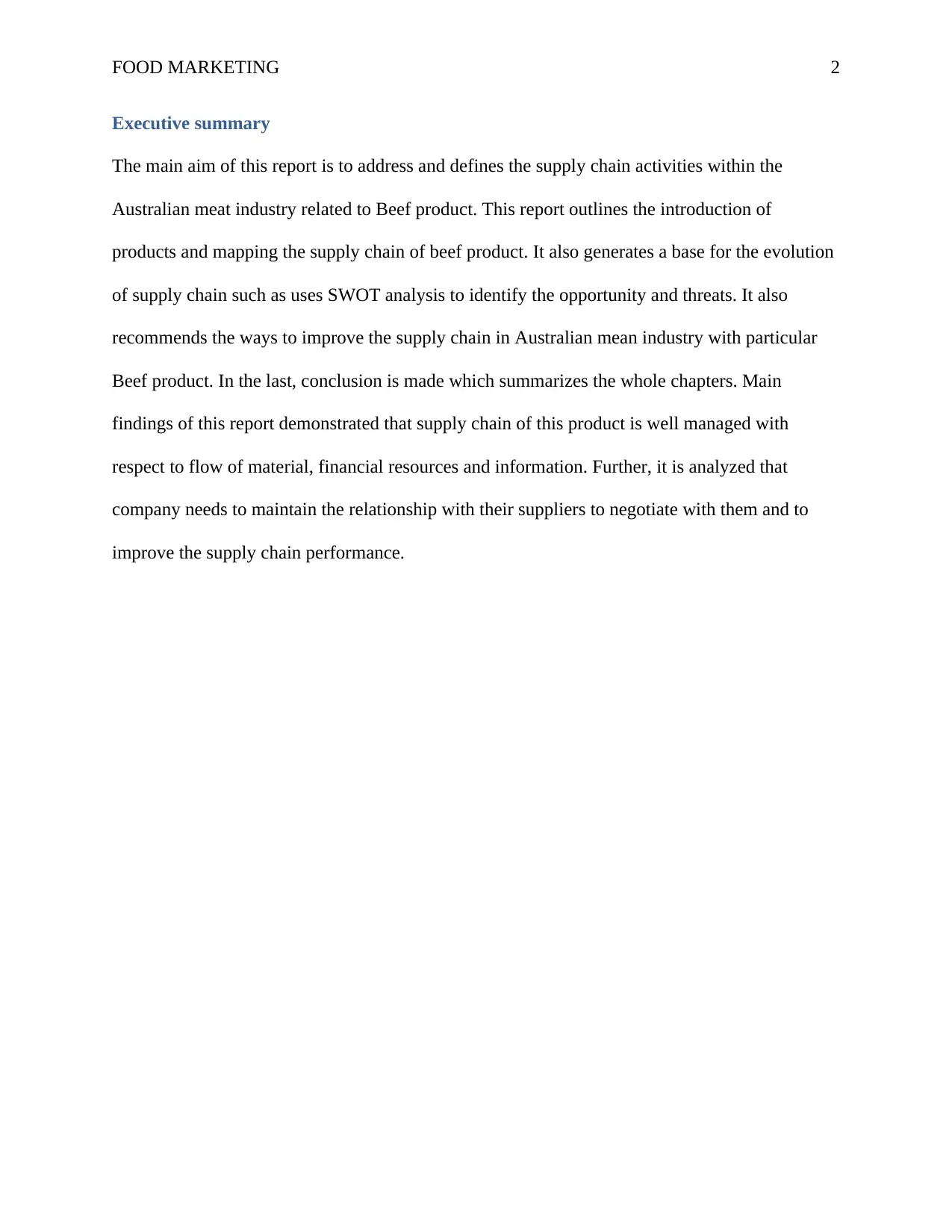
FOOD MARKETING 2
Executive summary
The main aim of this report is to address and defines the supply chain activities within the
Australian meat industry related to Beef product. This report outlines the introduction of
products and mapping the supply chain of beef product. It also generates a base for the evolution
of supply chain such as uses SWOT analysis to identify the opportunity and threats. It also
recommends the ways to improve the supply chain in Australian mean industry with particular
Beef product. In the last, conclusion is made which summarizes the whole chapters. Main
findings of this report demonstrated that supply chain of this product is well managed with
respect to flow of material, financial resources and information. Further, it is analyzed that
company needs to maintain the relationship with their suppliers to negotiate with them and to
improve the supply chain performance.
Executive summary
The main aim of this report is to address and defines the supply chain activities within the
Australian meat industry related to Beef product. This report outlines the introduction of
products and mapping the supply chain of beef product. It also generates a base for the evolution
of supply chain such as uses SWOT analysis to identify the opportunity and threats. It also
recommends the ways to improve the supply chain in Australian mean industry with particular
Beef product. In the last, conclusion is made which summarizes the whole chapters. Main
findings of this report demonstrated that supply chain of this product is well managed with
respect to flow of material, financial resources and information. Further, it is analyzed that
company needs to maintain the relationship with their suppliers to negotiate with them and to
improve the supply chain performance.
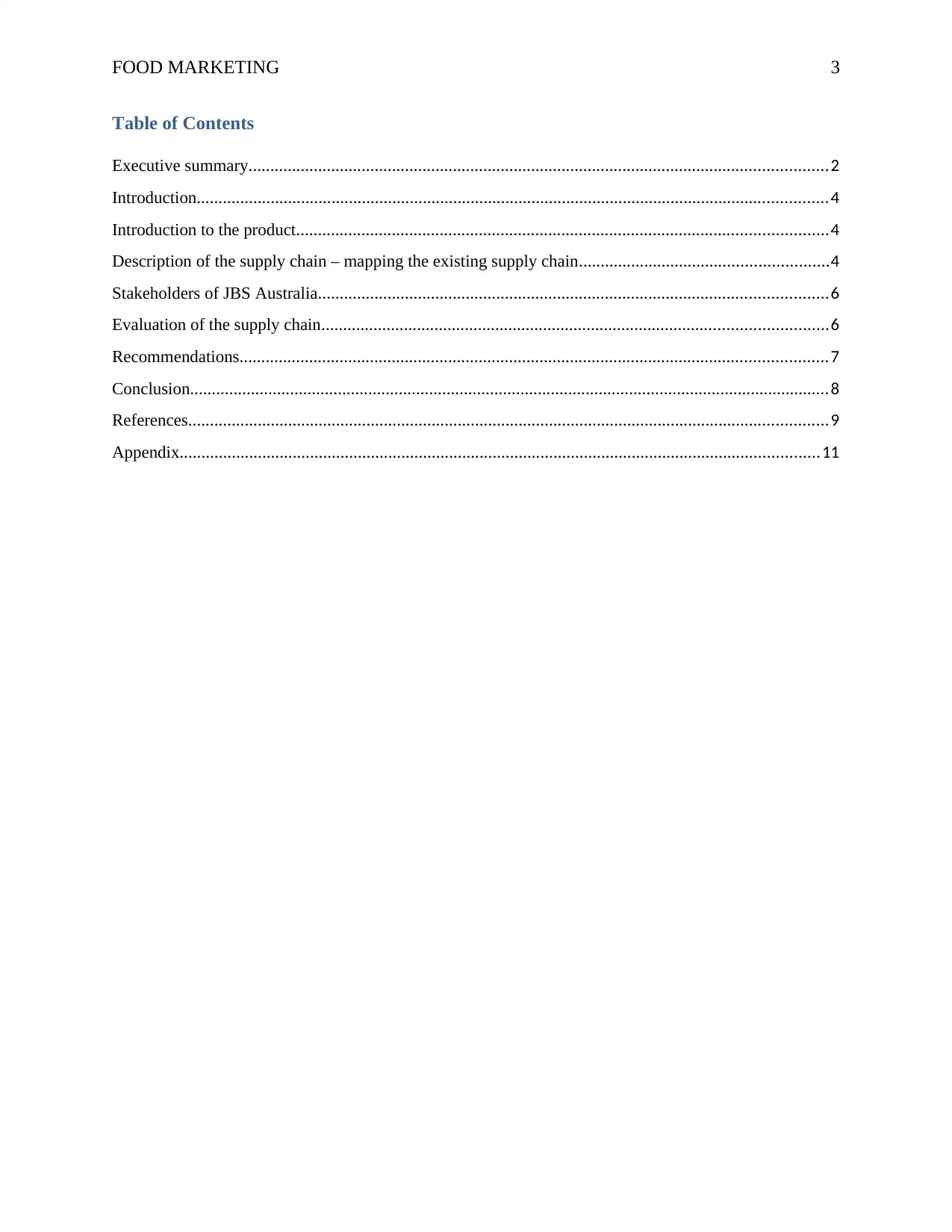
FOOD MARKETING 3
Table of Contents
Executive summary.....................................................................................................................................2
Introduction.................................................................................................................................................4
Introduction to the product..........................................................................................................................4
Description of the supply chain – mapping the existing supply chain.........................................................4
Stakeholders of JBS Australia.....................................................................................................................6
Evaluation of the supply chain....................................................................................................................6
Recommendations.......................................................................................................................................7
Conclusion...................................................................................................................................................8
References...................................................................................................................................................9
Appendix...................................................................................................................................................11
Table of Contents
Executive summary.....................................................................................................................................2
Introduction.................................................................................................................................................4
Introduction to the product..........................................................................................................................4
Description of the supply chain – mapping the existing supply chain.........................................................4
Stakeholders of JBS Australia.....................................................................................................................6
Evaluation of the supply chain....................................................................................................................6
Recommendations.......................................................................................................................................7
Conclusion...................................................................................................................................................8
References...................................................................................................................................................9
Appendix...................................................................................................................................................11
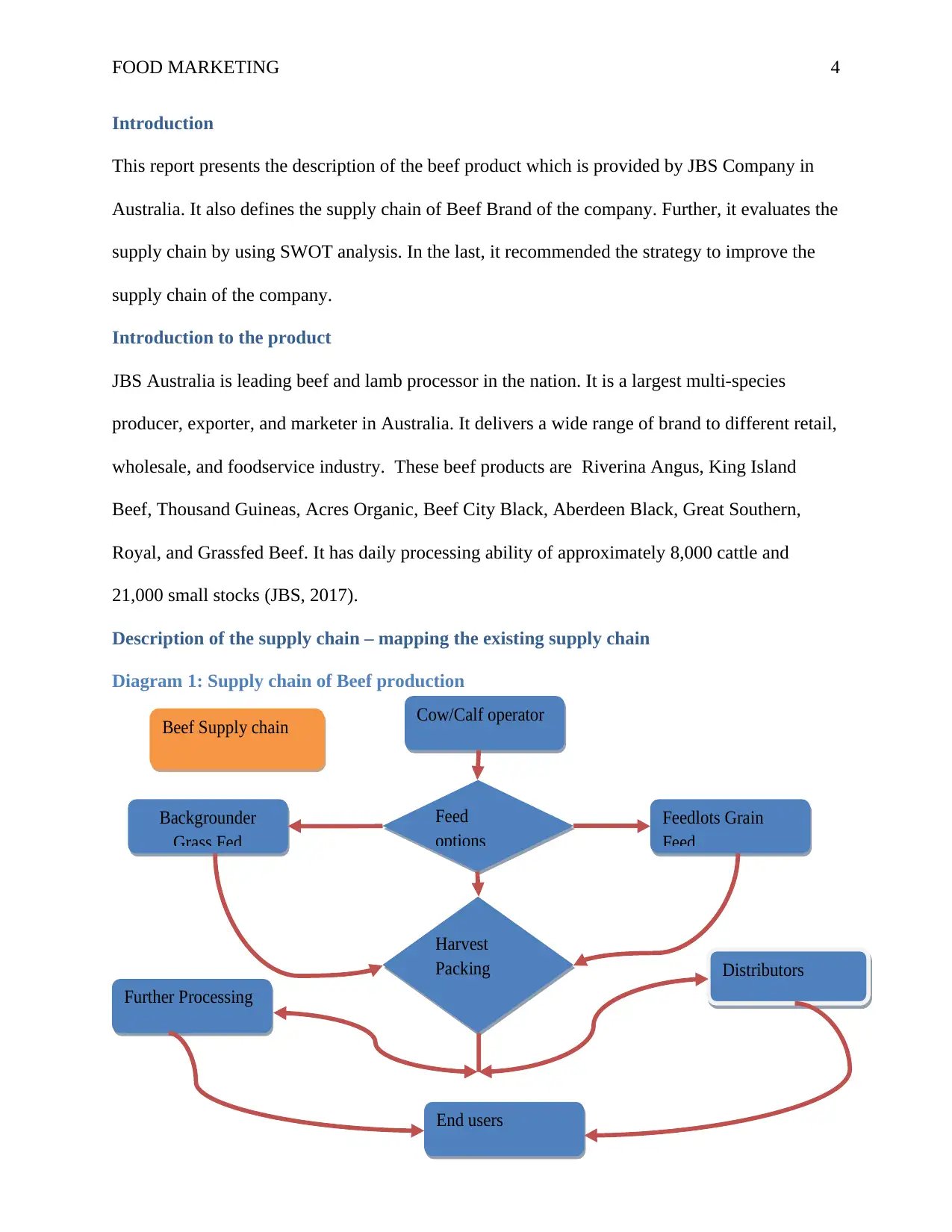
FOOD MARKETING 4
Introduction
This report presents the description of the beef product which is provided by JBS Company in
Australia. It also defines the supply chain of Beef Brand of the company. Further, it evaluates the
supply chain by using SWOT analysis. In the last, it recommended the strategy to improve the
supply chain of the company.
Introduction to the product
JBS Australia is leading beef and lamb processor in the nation. It is a largest multi-species
producer, exporter, and marketer in Australia. It delivers a wide range of brand to different retail,
wholesale, and foodservice industry. These beef products are Riverina Angus, King Island
Beef, Thousand Guineas, Acres Organic, Beef City Black, Aberdeen Black, Great Southern,
Royal, and Grassfed Beef. It has daily processing ability of approximately 8,000 cattle and
21,000 small stocks (JBS, 2017).
Description of the supply chain – mapping the existing supply chain
Diagram 1: Supply chain of Beef production
Cow/Calf operator
Further Processing
End users
Distributors
Backgrounder
Grass Fed
Feedlots Grain
Feed
Feed
options
Harvest
Packing
Beef Supply chain
Introduction
This report presents the description of the beef product which is provided by JBS Company in
Australia. It also defines the supply chain of Beef Brand of the company. Further, it evaluates the
supply chain by using SWOT analysis. In the last, it recommended the strategy to improve the
supply chain of the company.
Introduction to the product
JBS Australia is leading beef and lamb processor in the nation. It is a largest multi-species
producer, exporter, and marketer in Australia. It delivers a wide range of brand to different retail,
wholesale, and foodservice industry. These beef products are Riverina Angus, King Island
Beef, Thousand Guineas, Acres Organic, Beef City Black, Aberdeen Black, Great Southern,
Royal, and Grassfed Beef. It has daily processing ability of approximately 8,000 cattle and
21,000 small stocks (JBS, 2017).
Description of the supply chain – mapping the existing supply chain
Diagram 1: Supply chain of Beef production
Cow/Calf operator
Further Processing
End users
Distributors
Backgrounder
Grass Fed
Feedlots Grain
Feed
Feed
options
Harvest
Packing
Beef Supply chain
Secure Best Marks with AI Grader
Need help grading? Try our AI Grader for instant feedback on your assignments.
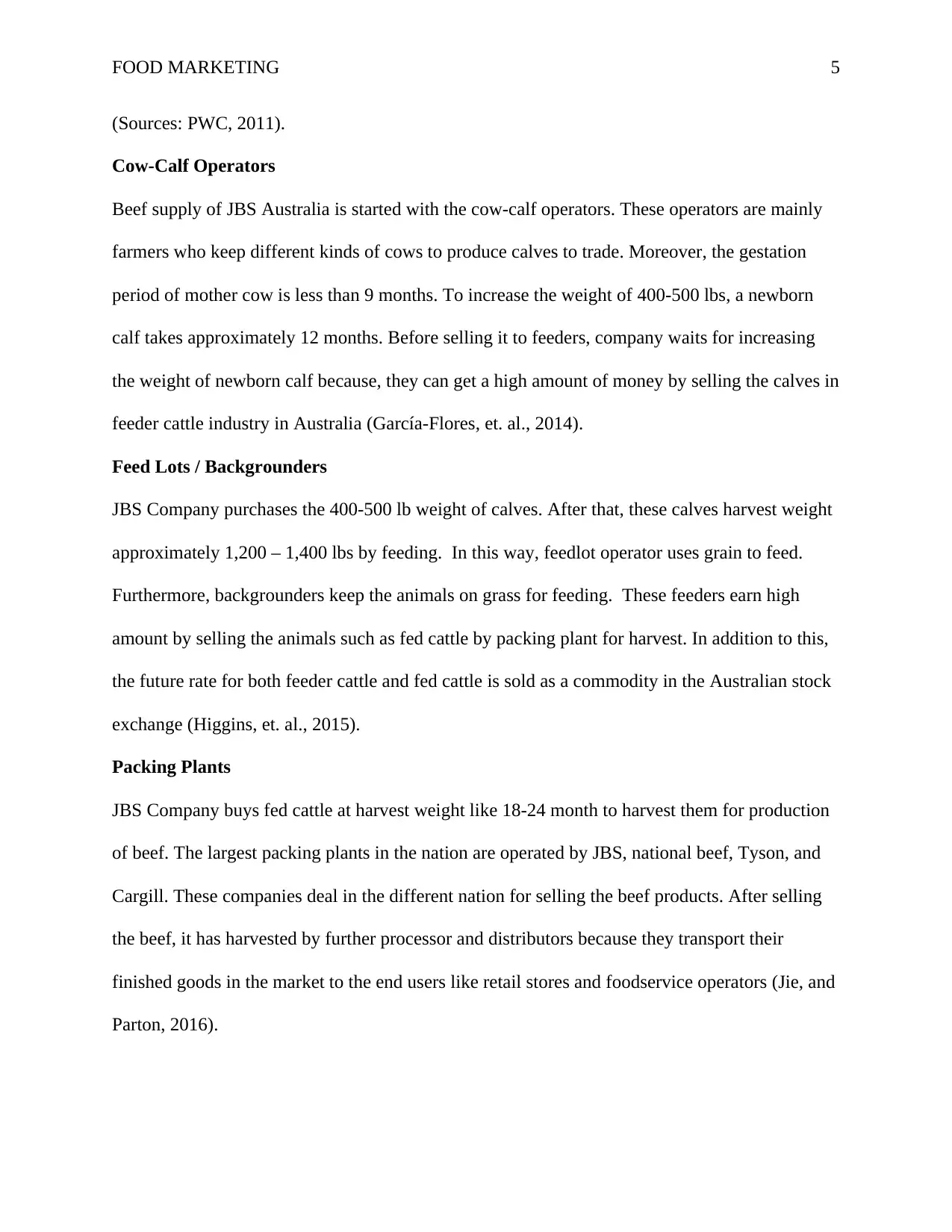
FOOD MARKETING 5
(Sources: PWC, 2011).
Cow-Calf Operators
Beef supply of JBS Australia is started with the cow-calf operators. These operators are mainly
farmers who keep different kinds of cows to produce calves to trade. Moreover, the gestation
period of mother cow is less than 9 months. To increase the weight of 400-500 lbs, a newborn
calf takes approximately 12 months. Before selling it to feeders, company waits for increasing
the weight of newborn calf because, they can get a high amount of money by selling the calves in
feeder cattle industry in Australia (García-Flores, et. al., 2014).
Feed Lots / Backgrounders
JBS Company purchases the 400-500 lb weight of calves. After that, these calves harvest weight
approximately 1,200 – 1,400 lbs by feeding. In this way, feedlot operator uses grain to feed.
Furthermore, backgrounders keep the animals on grass for feeding. These feeders earn high
amount by selling the animals such as fed cattle by packing plant for harvest. In addition to this,
the future rate for both feeder cattle and fed cattle is sold as a commodity in the Australian stock
exchange (Higgins, et. al., 2015).
Packing Plants
JBS Company buys fed cattle at harvest weight like 18-24 month to harvest them for production
of beef. The largest packing plants in the nation are operated by JBS, national beef, Tyson, and
Cargill. These companies deal in the different nation for selling the beef products. After selling
the beef, it has harvested by further processor and distributors because they transport their
finished goods in the market to the end users like retail stores and foodservice operators (Jie, and
Parton, 2016).
(Sources: PWC, 2011).
Cow-Calf Operators
Beef supply of JBS Australia is started with the cow-calf operators. These operators are mainly
farmers who keep different kinds of cows to produce calves to trade. Moreover, the gestation
period of mother cow is less than 9 months. To increase the weight of 400-500 lbs, a newborn
calf takes approximately 12 months. Before selling it to feeders, company waits for increasing
the weight of newborn calf because, they can get a high amount of money by selling the calves in
feeder cattle industry in Australia (García-Flores, et. al., 2014).
Feed Lots / Backgrounders
JBS Company purchases the 400-500 lb weight of calves. After that, these calves harvest weight
approximately 1,200 – 1,400 lbs by feeding. In this way, feedlot operator uses grain to feed.
Furthermore, backgrounders keep the animals on grass for feeding. These feeders earn high
amount by selling the animals such as fed cattle by packing plant for harvest. In addition to this,
the future rate for both feeder cattle and fed cattle is sold as a commodity in the Australian stock
exchange (Higgins, et. al., 2015).
Packing Plants
JBS Company buys fed cattle at harvest weight like 18-24 month to harvest them for production
of beef. The largest packing plants in the nation are operated by JBS, national beef, Tyson, and
Cargill. These companies deal in the different nation for selling the beef products. After selling
the beef, it has harvested by further processor and distributors because they transport their
finished goods in the market to the end users like retail stores and foodservice operators (Jie, and
Parton, 2016).
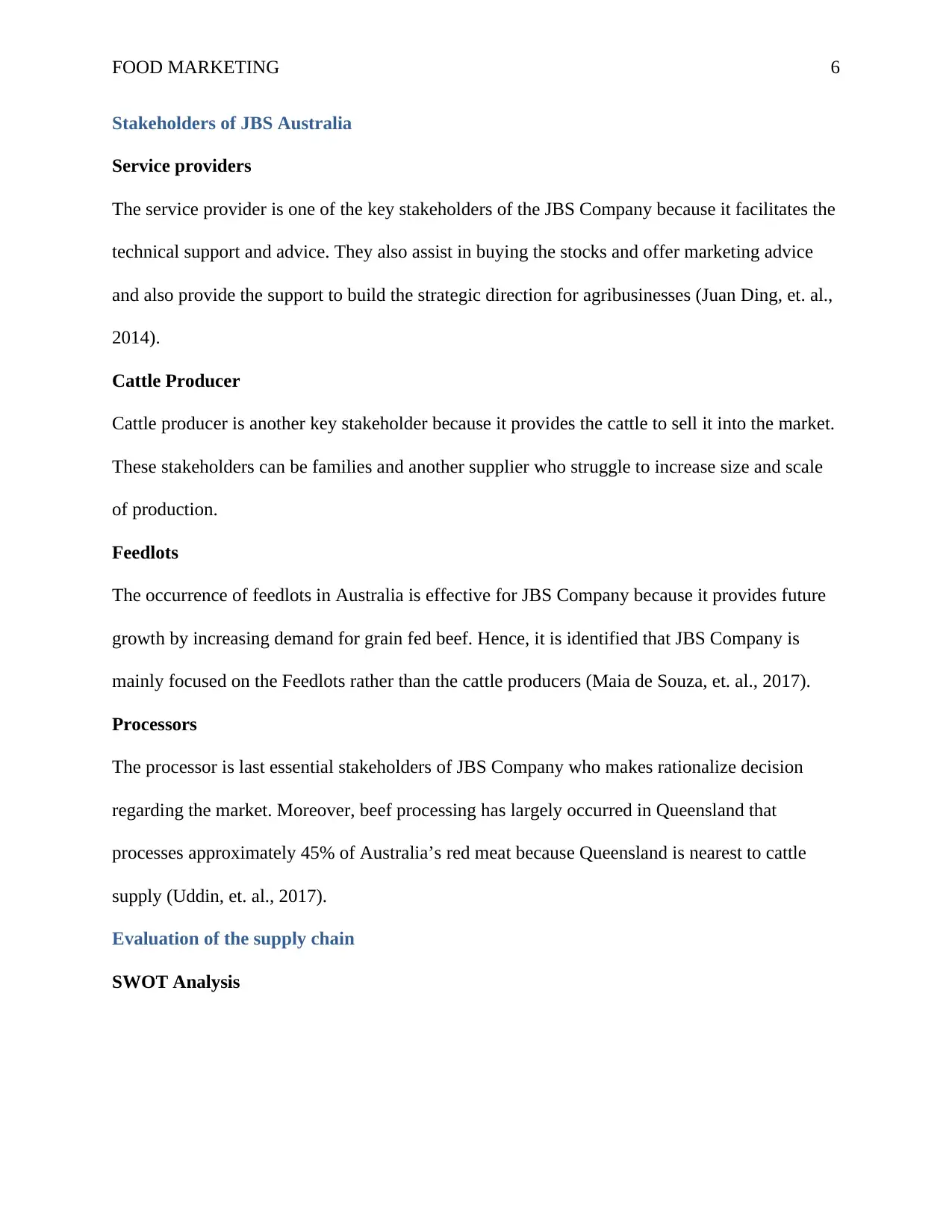
FOOD MARKETING 6
Stakeholders of JBS Australia
Service providers
The service provider is one of the key stakeholders of the JBS Company because it facilitates the
technical support and advice. They also assist in buying the stocks and offer marketing advice
and also provide the support to build the strategic direction for agribusinesses (Juan Ding, et. al.,
2014).
Cattle Producer
Cattle producer is another key stakeholder because it provides the cattle to sell it into the market.
These stakeholders can be families and another supplier who struggle to increase size and scale
of production.
Feedlots
The occurrence of feedlots in Australia is effective for JBS Company because it provides future
growth by increasing demand for grain fed beef. Hence, it is identified that JBS Company is
mainly focused on the Feedlots rather than the cattle producers (Maia de Souza, et. al., 2017).
Processors
The processor is last essential stakeholders of JBS Company who makes rationalize decision
regarding the market. Moreover, beef processing has largely occurred in Queensland that
processes approximately 45% of Australia’s red meat because Queensland is nearest to cattle
supply (Uddin, et. al., 2017).
Evaluation of the supply chain
SWOT Analysis
Stakeholders of JBS Australia
Service providers
The service provider is one of the key stakeholders of the JBS Company because it facilitates the
technical support and advice. They also assist in buying the stocks and offer marketing advice
and also provide the support to build the strategic direction for agribusinesses (Juan Ding, et. al.,
2014).
Cattle Producer
Cattle producer is another key stakeholder because it provides the cattle to sell it into the market.
These stakeholders can be families and another supplier who struggle to increase size and scale
of production.
Feedlots
The occurrence of feedlots in Australia is effective for JBS Company because it provides future
growth by increasing demand for grain fed beef. Hence, it is identified that JBS Company is
mainly focused on the Feedlots rather than the cattle producers (Maia de Souza, et. al., 2017).
Processors
The processor is last essential stakeholders of JBS Company who makes rationalize decision
regarding the market. Moreover, beef processing has largely occurred in Queensland that
processes approximately 45% of Australia’s red meat because Queensland is nearest to cattle
supply (Uddin, et. al., 2017).
Evaluation of the supply chain
SWOT Analysis
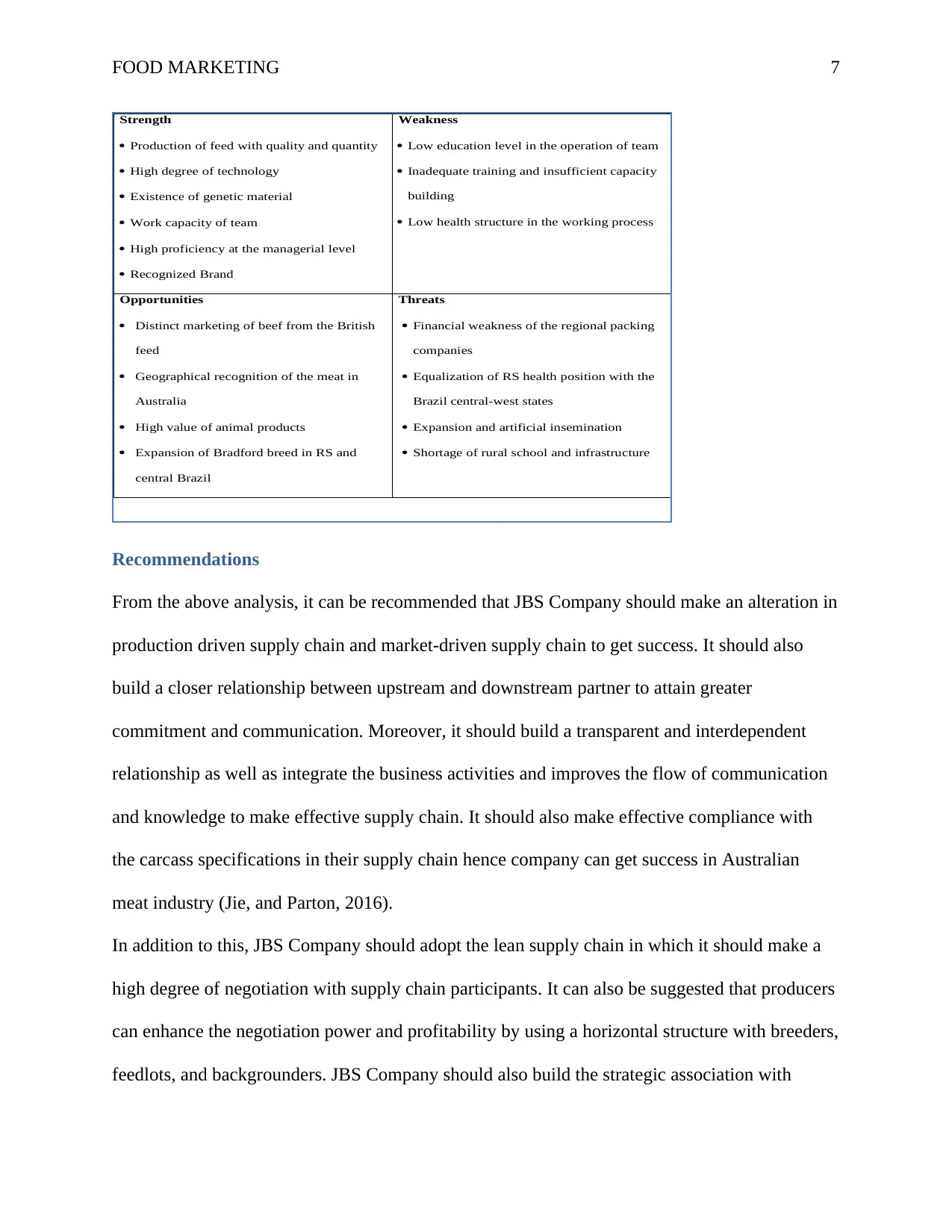
FOOD MARKETING 7
Strength
Production of feed with quality and quantity
High degree of technology
Existence of genetic material
Work capacity of team
High proficiency at the managerial level
Recognized Brand
Weakness
Low education level in the operation of team
Inadequate training and insufficient capacity
building
Low health structure in the working process
Opportunities
Distinct marketing of beef from the British
feed
Geographical recognition of the meat in
Australia
High value of animal products
Expansion of Bradford breed in RS and
central Brazil
Threats
Financial weakness of the regional packing
companies
Equalization of RS health position with the
Brazil central-west states
Expansion and artificial insemination
Shortage of rural school and infrastructure
Recommendations
From the above analysis, it can be recommended that JBS Company should make an alteration in
production driven supply chain and market-driven supply chain to get success. It should also
build a closer relationship between upstream and downstream partner to attain greater
commitment and communication. Moreover, it should build a transparent and interdependent
relationship as well as integrate the business activities and improves the flow of communication
and knowledge to make effective supply chain. It should also make effective compliance with
the carcass specifications in their supply chain hence company can get success in Australian
meat industry (Jie, and Parton, 2016).
In addition to this, JBS Company should adopt the lean supply chain in which it should make a
high degree of negotiation with supply chain participants. It can also be suggested that producers
can enhance the negotiation power and profitability by using a horizontal structure with breeders,
feedlots, and backgrounders. JBS Company should also build the strategic association with
Strength
Production of feed with quality and quantity
High degree of technology
Existence of genetic material
Work capacity of team
High proficiency at the managerial level
Recognized Brand
Weakness
Low education level in the operation of team
Inadequate training and insufficient capacity
building
Low health structure in the working process
Opportunities
Distinct marketing of beef from the British
feed
Geographical recognition of the meat in
Australia
High value of animal products
Expansion of Bradford breed in RS and
central Brazil
Threats
Financial weakness of the regional packing
companies
Equalization of RS health position with the
Brazil central-west states
Expansion and artificial insemination
Shortage of rural school and infrastructure
Recommendations
From the above analysis, it can be recommended that JBS Company should make an alteration in
production driven supply chain and market-driven supply chain to get success. It should also
build a closer relationship between upstream and downstream partner to attain greater
commitment and communication. Moreover, it should build a transparent and interdependent
relationship as well as integrate the business activities and improves the flow of communication
and knowledge to make effective supply chain. It should also make effective compliance with
the carcass specifications in their supply chain hence company can get success in Australian
meat industry (Jie, and Parton, 2016).
In addition to this, JBS Company should adopt the lean supply chain in which it should make a
high degree of negotiation with supply chain participants. It can also be suggested that producers
can enhance the negotiation power and profitability by using a horizontal structure with breeders,
feedlots, and backgrounders. JBS Company should also build the strategic association with
Paraphrase This Document
Need a fresh take? Get an instant paraphrase of this document with our AI Paraphraser
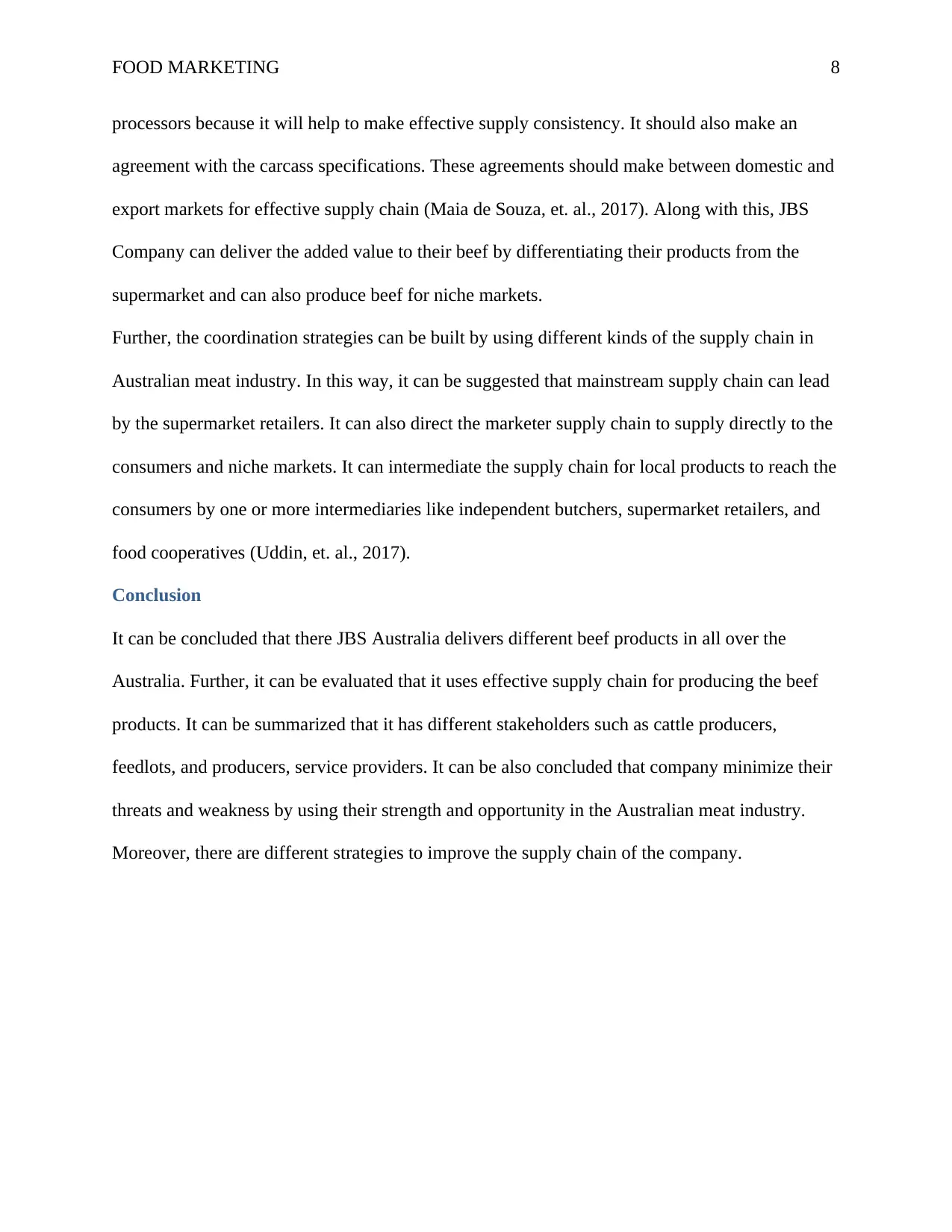
FOOD MARKETING 8
processors because it will help to make effective supply consistency. It should also make an
agreement with the carcass specifications. These agreements should make between domestic and
export markets for effective supply chain (Maia de Souza, et. al., 2017). Along with this, JBS
Company can deliver the added value to their beef by differentiating their products from the
supermarket and can also produce beef for niche markets.
Further, the coordination strategies can be built by using different kinds of the supply chain in
Australian meat industry. In this way, it can be suggested that mainstream supply chain can lead
by the supermarket retailers. It can also direct the marketer supply chain to supply directly to the
consumers and niche markets. It can intermediate the supply chain for local products to reach the
consumers by one or more intermediaries like independent butchers, supermarket retailers, and
food cooperatives (Uddin, et. al., 2017).
Conclusion
It can be concluded that there JBS Australia delivers different beef products in all over the
Australia. Further, it can be evaluated that it uses effective supply chain for producing the beef
products. It can be summarized that it has different stakeholders such as cattle producers,
feedlots, and producers, service providers. It can be also concluded that company minimize their
threats and weakness by using their strength and opportunity in the Australian meat industry.
Moreover, there are different strategies to improve the supply chain of the company.
processors because it will help to make effective supply consistency. It should also make an
agreement with the carcass specifications. These agreements should make between domestic and
export markets for effective supply chain (Maia de Souza, et. al., 2017). Along with this, JBS
Company can deliver the added value to their beef by differentiating their products from the
supermarket and can also produce beef for niche markets.
Further, the coordination strategies can be built by using different kinds of the supply chain in
Australian meat industry. In this way, it can be suggested that mainstream supply chain can lead
by the supermarket retailers. It can also direct the marketer supply chain to supply directly to the
consumers and niche markets. It can intermediate the supply chain for local products to reach the
consumers by one or more intermediaries like independent butchers, supermarket retailers, and
food cooperatives (Uddin, et. al., 2017).
Conclusion
It can be concluded that there JBS Australia delivers different beef products in all over the
Australia. Further, it can be evaluated that it uses effective supply chain for producing the beef
products. It can be summarized that it has different stakeholders such as cattle producers,
feedlots, and producers, service providers. It can be also concluded that company minimize their
threats and weakness by using their strength and opportunity in the Australian meat industry.
Moreover, there are different strategies to improve the supply chain of the company.
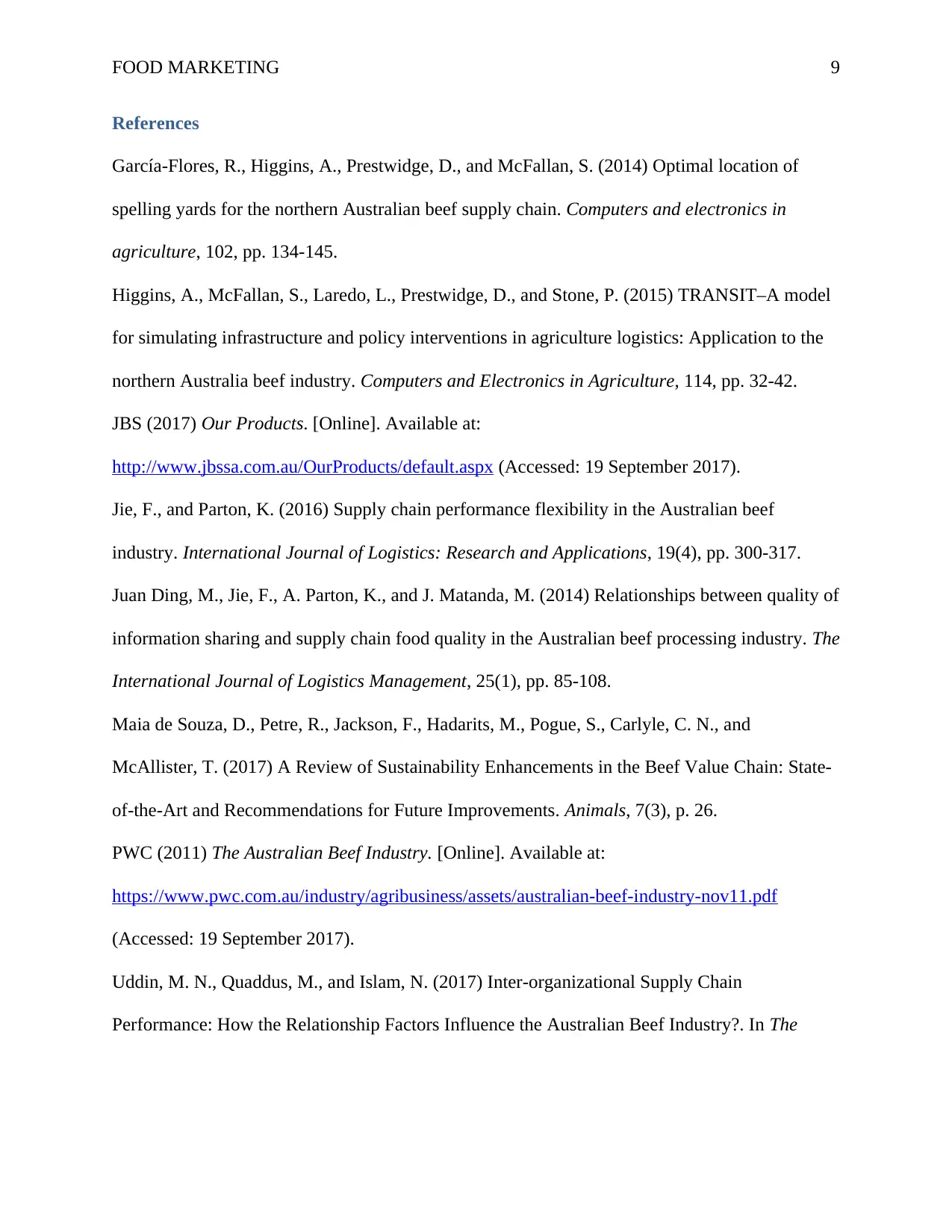
FOOD MARKETING 9
References
García-Flores, R., Higgins, A., Prestwidge, D., and McFallan, S. (2014) Optimal location of
spelling yards for the northern Australian beef supply chain. Computers and electronics in
agriculture, 102, pp. 134-145.
Higgins, A., McFallan, S., Laredo, L., Prestwidge, D., and Stone, P. (2015) TRANSIT–A model
for simulating infrastructure and policy interventions in agriculture logistics: Application to the
northern Australia beef industry. Computers and Electronics in Agriculture, 114, pp. 32-42.
JBS (2017) Our Products. [Online]. Available at:
http://www.jbssa.com.au/OurProducts/default.aspx (Accessed: 19 September 2017).
Jie, F., and Parton, K. (2016) Supply chain performance flexibility in the Australian beef
industry. International Journal of Logistics: Research and Applications, 19(4), pp. 300-317.
Juan Ding, M., Jie, F., A. Parton, K., and J. Matanda, M. (2014) Relationships between quality of
information sharing and supply chain food quality in the Australian beef processing industry. The
International Journal of Logistics Management, 25(1), pp. 85-108.
Maia de Souza, D., Petre, R., Jackson, F., Hadarits, M., Pogue, S., Carlyle, C. N., and
McAllister, T. (2017) A Review of Sustainability Enhancements in the Beef Value Chain: State-
of-the-Art and Recommendations for Future Improvements. Animals, 7(3), p. 26.
PWC (2011) The Australian Beef Industry. [Online]. Available at:
https://www.pwc.com.au/industry/agribusiness/assets/australian-beef-industry-nov11.pdf
(Accessed: 19 September 2017).
Uddin, M. N., Quaddus, M., and Islam, N. (2017) Inter-organizational Supply Chain
Performance: How the Relationship Factors Influence the Australian Beef Industry?. In The
References
García-Flores, R., Higgins, A., Prestwidge, D., and McFallan, S. (2014) Optimal location of
spelling yards for the northern Australian beef supply chain. Computers and electronics in
agriculture, 102, pp. 134-145.
Higgins, A., McFallan, S., Laredo, L., Prestwidge, D., and Stone, P. (2015) TRANSIT–A model
for simulating infrastructure and policy interventions in agriculture logistics: Application to the
northern Australia beef industry. Computers and Electronics in Agriculture, 114, pp. 32-42.
JBS (2017) Our Products. [Online]. Available at:
http://www.jbssa.com.au/OurProducts/default.aspx (Accessed: 19 September 2017).
Jie, F., and Parton, K. (2016) Supply chain performance flexibility in the Australian beef
industry. International Journal of Logistics: Research and Applications, 19(4), pp. 300-317.
Juan Ding, M., Jie, F., A. Parton, K., and J. Matanda, M. (2014) Relationships between quality of
information sharing and supply chain food quality in the Australian beef processing industry. The
International Journal of Logistics Management, 25(1), pp. 85-108.
Maia de Souza, D., Petre, R., Jackson, F., Hadarits, M., Pogue, S., Carlyle, C. N., and
McAllister, T. (2017) A Review of Sustainability Enhancements in the Beef Value Chain: State-
of-the-Art and Recommendations for Future Improvements. Animals, 7(3), p. 26.
PWC (2011) The Australian Beef Industry. [Online]. Available at:
https://www.pwc.com.au/industry/agribusiness/assets/australian-beef-industry-nov11.pdf
(Accessed: 19 September 2017).
Uddin, M. N., Quaddus, M., and Islam, N. (2017) Inter-organizational Supply Chain
Performance: How the Relationship Factors Influence the Australian Beef Industry?. In The

FOOD MARKETING 10
Customer is NOT Always Right? Marketing Orientations in a Dynamic Business World (pp. 458-
464). Germany: Springer, Cham.
Customer is NOT Always Right? Marketing Orientations in a Dynamic Business World (pp. 458-
464). Germany: Springer, Cham.
Secure Best Marks with AI Grader
Need help grading? Try our AI Grader for instant feedback on your assignments.
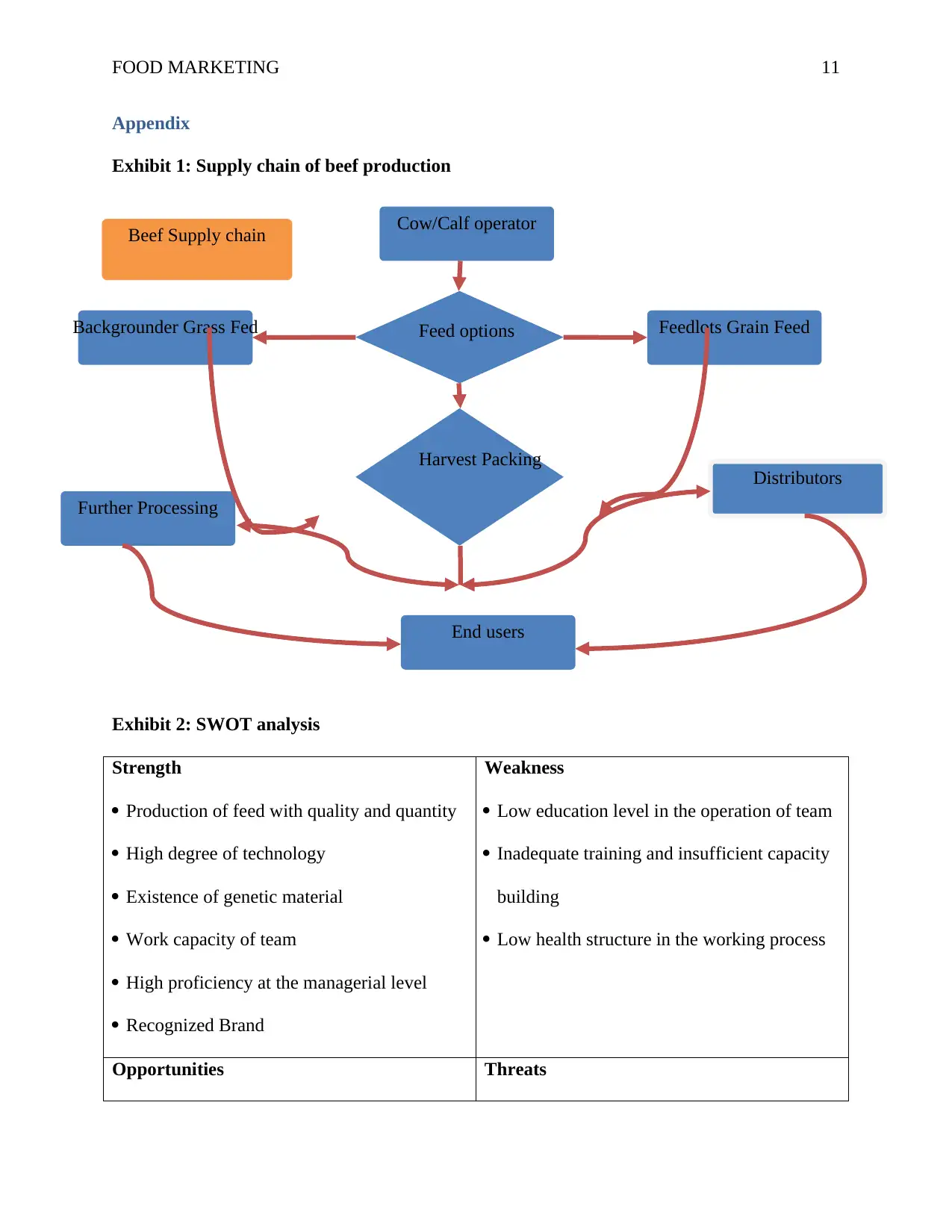
Cow/Calf operator
Further Processing
End users
Distributors
Backgrounder Grass Fed Feedlots Grain FeedFeed options
Harvest Packing
Beef Supply chain
FOOD MARKETING 11
Appendix
Exhibit 1: Supply chain of beef production
Exhibit 2: SWOT analysis
Strength
Production of feed with quality and quantity
High degree of technology
Existence of genetic material
Work capacity of team
High proficiency at the managerial level
Recognized Brand
Weakness
Low education level in the operation of team
Inadequate training and insufficient capacity
building
Low health structure in the working process
Opportunities Threats
Further Processing
End users
Distributors
Backgrounder Grass Fed Feedlots Grain FeedFeed options
Harvest Packing
Beef Supply chain
FOOD MARKETING 11
Appendix
Exhibit 1: Supply chain of beef production
Exhibit 2: SWOT analysis
Strength
Production of feed with quality and quantity
High degree of technology
Existence of genetic material
Work capacity of team
High proficiency at the managerial level
Recognized Brand
Weakness
Low education level in the operation of team
Inadequate training and insufficient capacity
building
Low health structure in the working process
Opportunities Threats
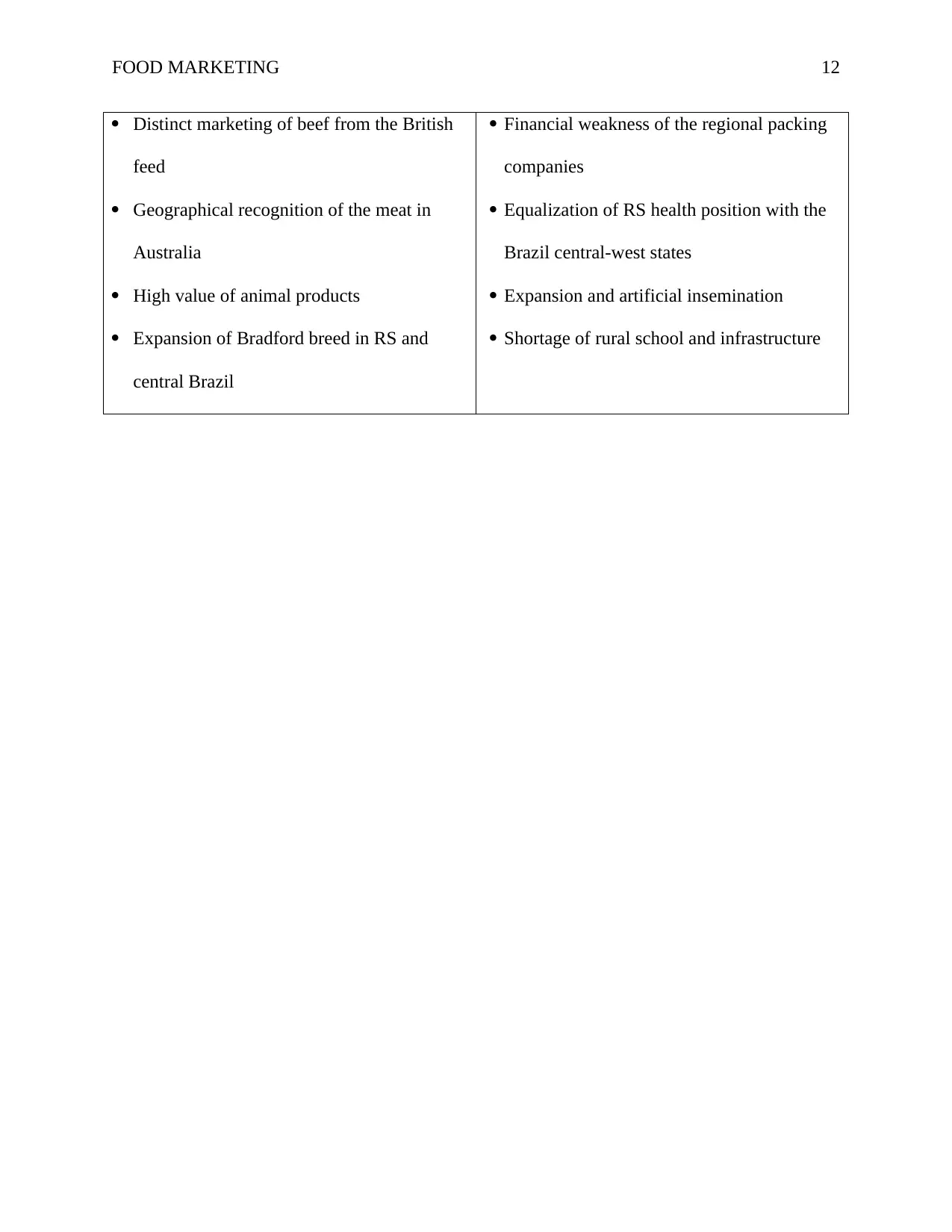
FOOD MARKETING 12
Distinct marketing of beef from the British
feed
Geographical recognition of the meat in
Australia
High value of animal products
Expansion of Bradford breed in RS and
central Brazil
Financial weakness of the regional packing
companies
Equalization of RS health position with the
Brazil central-west states
Expansion and artificial insemination
Shortage of rural school and infrastructure
Distinct marketing of beef from the British
feed
Geographical recognition of the meat in
Australia
High value of animal products
Expansion of Bradford breed in RS and
central Brazil
Financial weakness of the regional packing
companies
Equalization of RS health position with the
Brazil central-west states
Expansion and artificial insemination
Shortage of rural school and infrastructure
1 out of 12
Your All-in-One AI-Powered Toolkit for Academic Success.
+13062052269
info@desklib.com
Available 24*7 on WhatsApp / Email
![[object Object]](/_next/static/media/star-bottom.7253800d.svg)
Unlock your academic potential
© 2024 | Zucol Services PVT LTD | All rights reserved.